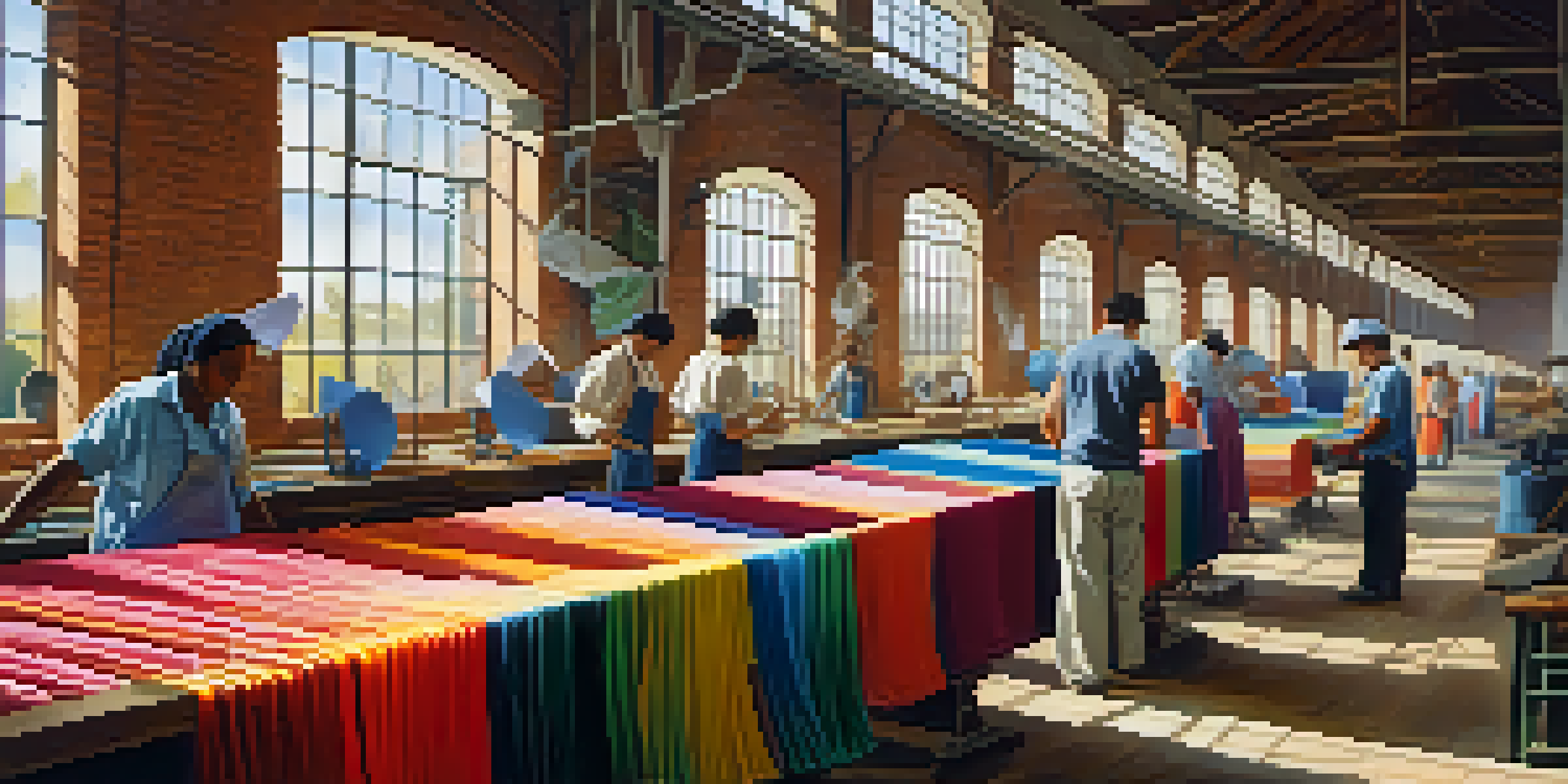The Lifecycle of Clothing: From Production to Disposal

The Beginning: Raw Materials and Fabric Production
Every piece of clothing starts with raw materials, such as cotton, wool, or synthetic fibers. These materials undergo various processes to become fabric, which is the foundation of our clothing. For example, cotton is harvested from plants, processed, and spun into threads before being woven into fabric.
The greatest threat to our planet is the belief that someone else will save it.
The choice of raw materials significantly affects the environment. Organic cotton, for instance, requires less water and avoids harmful pesticides, making it a more sustainable option compared to conventional cotton. As consumers, being aware of these choices can help us support more eco-friendly practices.
Once the fabric is ready, it’s sent to manufacturers who convert it into garments. This stage involves cutting, sewing, and finishing processes that turn basic fabric into the stylish clothes we wear today. It's a fascinating transformation that lays the groundwork for the entire lifecycle of clothing.
Manufacturing: The Heart of Clothing Production
The manufacturing stage is where the magic happens, bringing designs to life. Factories around the world produce vast quantities of clothing, often in just a few hours. However, this rapid production raises questions about labor practices and environmental impacts.

Many clothing items are made in countries where labor laws may not be strict, leading to ethical concerns. Workers often face long hours and low wages, prompting a call for transparency in the fashion industry. Supporting brands that prioritize fair labor practices can help change this narrative.
Sustainable Materials Matter
Choosing eco-friendly raw materials, like organic cotton, can significantly reduce environmental impact.
Additionally, the manufacturing process can be resource-intensive, consuming significant amounts of water and energy. By choosing sustainable brands that focus on reducing waste and energy use, consumers can contribute to a healthier planet while still enjoying fashion.
Distribution: Getting Clothes from Factories to Consumers
Once manufactured, clothing needs to reach consumers, which is where distribution comes in. This stage involves shipping garments to stores and online platforms worldwide. Transportation, however, contributes to carbon emissions, impacting our environment.
Fashion is the armor to survive the reality of everyday life.
Brands are increasingly exploring ways to minimize their carbon footprint during distribution. For example, some companies are investing in local production to reduce shipping distances, while others are adopting eco-friendly packaging to lessen waste. These initiatives show that the industry is evolving towards more sustainable practices.
As consumers, we can also play a role by supporting local businesses and choosing brands that prioritize eco-conscious distribution methods. Every little decision can collectively make a big difference in reducing the environmental impact of our clothing choices.
Retail: The Final Stop Before Purchase
Retail is the stage where consumers interact with clothing directly. Whether in a brick-and-mortar store or online, this is where decisions are made about what to buy and wear. Retailers often use marketing strategies to entice consumers, but it’s essential to consider the implications of our purchases.
Fast fashion retailers, for example, offer trendy clothes at low prices, encouraging impulse buying. However, this can lead to overconsumption and the eventual waste of clothing. By being mindful of what we buy, we can help combat this cycle of excessive waste.
Ethical Manufacturing is Key
Supporting brands that prioritize fair labor practices and sustainable production methods helps promote a healthier fashion industry.
Additionally, many retailers are now introducing sustainability initiatives, like recycling programs or sustainable collections. By supporting these efforts, we not only make better choices for ourselves but also help shift the industry towards a more sustainable model.
Usage: The Life of Clothing in Our Closets
Once we bring clothing home, the usage phase begins. This is where we enjoy and express ourselves through fashion. However, how we care for and use our clothes can significantly affect their lifespan and the environment.
For instance, washing clothes can be a hidden environmental challenge. It uses water and energy, and synthetic fibers can release microplastics into our water systems during washes. Adopting practices like washing in cold water or air-drying can extend the life of our clothing and reduce our ecological footprint.
Moreover, being mindful about how often we wear and wash our clothes can help reduce wear and tear. Creating a capsule wardrobe or opting for versatile pieces can not only simplify our lives but also promote sustainability by minimizing our overall consumption.
Maintenance: Caring for Clothes to Extend Their Lifespan
Caring for our clothing is crucial in extending their lifespan. Regular maintenance, such as washing, ironing, and repairing, can help keep garments looking fresh and new. Simple actions like following care labels can make a big difference in preserving the quality of our clothes.
In addition to basic care, learning simple sewing skills can empower us to repair minor damages instead of tossing items. Whether it’s sewing a button or mending a small tear, these skills can prolong the life of our favorite pieces and reduce waste.
Conscious Disposal Reduces Waste
Making thoughtful disposal choices, such as donating or recycling clothes, can help mitigate the growing waste crisis in fashion.
By taking the time to care for our clothing, we not only save money but also contribute to a more sustainable fashion cycle. Fostering a mindset of appreciation for our clothes encourages a more thoughtful and responsible approach to fashion.
Disposal: The End of the Clothing Lifecycle
Eventually, all clothing reaches the end of its lifecycle, leading to the crucial phase of disposal. Unfortunately, many garments end up in landfills, contributing to the growing waste crisis. Understanding the disposal options available to us can help mitigate this issue.
Before tossing clothes, consider donating them or selling them online. Many organizations accept gently used clothing, giving them a second life and reducing the amount of waste sent to landfills. Thrift shopping has become a popular trend, proving that second-hand clothes can be stylish and sustainable.

Moreover, some brands are now offering take-back programs, allowing consumers to return old clothing for recycling or repurposing. By making conscious disposal choices, we can help close the loop in the clothing lifecycle and promote a more sustainable future.